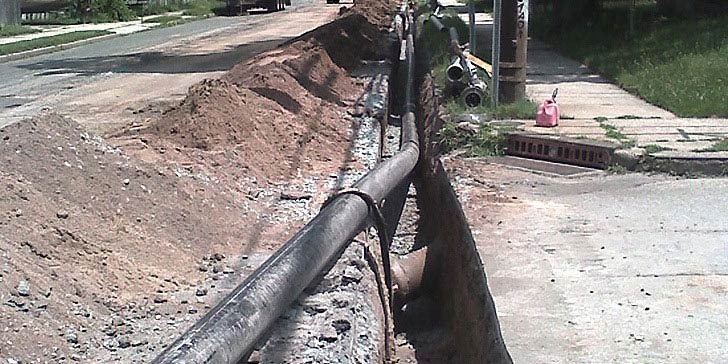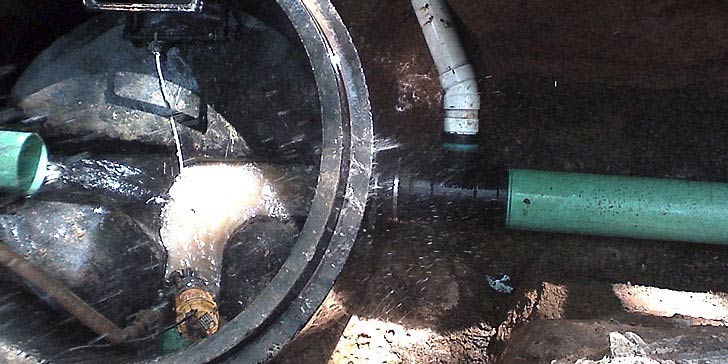We Offer Free Video Inspections!
ICUNJ has led the industry in implementing innovative solutions. No two
projects are the same, so our dedicated team of industry experts work
with you to develop customized solutions to meet the most
challenging conditions.
Relining Vs. Replacement
Trenchless technologies — the most common being relining with cured-in-place pipe (CIPP) — offer many benefits over more traditional efforts such as excavation.
Perhaps the most notable benefit is lower installation costs, which allows funds to be stretched further and rehabilitation programs to be fully extended. Combine the cost-savings with significantly less surface disruption and restoration efforts, and the choice to reline makes sense: More work is done for the money that is available, as well as happier constituents.
Relining also reduces or eliminates infiltration-and-inflow (I/I). As systems are being overloaded and treatment facilities are being forced to treat excessive clear water, reducing and eliminating I/I is critical. Costs to transport and treat are being scrutinized. Government agencies in some states are requiring a reduction in clear flow before granting permits for treatment plant expansions and capacity upgrades. Cities are being forced to attack the problem at its source and not deal with it in its end processes. CIPP and other rehabilitation techniques are vital components in achieving I/I reduction.
In addition to reducing and/or eliminating I/I, relining prevents exfiltration and protects the environment from the wastestream, an important aspect for not only sanitary sewers but also in process sewer piping. Further environmental advantages include eliminating the need to dispose of removed materials, especially critical in areas where sewers made of asbestos cement were installed.
Relining leaves sewer segments jointless from end to end. It provides Manning’s roughness coefficients as good as 0.010. The process is flexible and can, therefore, be designed as fully deteriorated — stand alone — in nature or as partially deteriorated and rely on the host to carry the external loads.
Used as more of a coating, relining can provide corrosion resistance and pipe protection, valuable in cases where tuberculation is occurring or where hydrogen sulfide or chemicals are causing or are anticipated to cause significant buildup or degradation in host pipes.
And trenchless technologies continue to advance. Air or steam curing is becoming more prevalent, reducing installation times and curing cycles, which further reduces service disruption to sewer customers. Ultraviolet light is being used in curing laminates. New tube technology includes the introduction of fiberglass and even carbon fibers, allowing for higher-strength, thinner laminates.
The Process Should Match the Problem
While relining offers these and other benefits and has become the method of choice in rehabilitation programs, it is not the cure-all and must be used in conjunction with other rehabilitation techniques — one of those being excavation. Excavation is the oldest form of rehabilitation available and will likely always have its place in the rehabilitation market.
There are times when replacement needs to, and should, be considered. For example, relining does not repair significant sags. While it can help smooth out a sagged section, it cannot entirely repair it. Relining cannot correct grade alignment issues. It can help improve the flow characteristics, but will not correct a reverse or improperly laid pipe segment. Excavation and replacement is often a viable option when those situations exist and require correction.
Relining does not reround pipe as it conforms to the host pipe’s original shape. When ovalities reach 20 percent and greater, alternate design methodologies other than ASTM F1216 need to be considered. Badly ovaled sections generally need to be replaced, as this is likely a clear sign that the soil stability surrounding the pipe is in need of repair. Relining cannot restore soil stability, but excavation can.
Relining is not the right method for filling large voids and gaps outside of the host pipes. There are some internal processes available to do that but again excavation should be considered. Issues in smaller diameter mains — 6 in. and less — where diameter alone or alignment issues prevent the internal reopening of service connections, are also situations that call for excavation.
For upsizing in growing areas and extensive urban renewal programs that include utility repairs, replacements or upgrades and surface restoration benefits like repaving roads and installing new curbs and sidewalks, sometimes replacement can be as cost-effective as relining.
Understandably, trenchless is the rehabilitation method of choice. But for a proper and realistic approach to a rehabilitation project or an entire program — especially one that will ensure the system integrity remains intact and capacity is adequate — replacement must also be considered. Often repairs requiring excavation get put on the backburner and the less expensive repair methodologies, like CIPP, are deployed first. This is a risky approach. What requires a relatively basic excavation today, could easily turn into a catastrophic failure and an emergency repair in the near future. Financial costs associated with those can be astounding.
Take a Comprehensive Approach
The current trend toward design-build contracting with full-service contractors and engineering partners can help ensure the appropriate blending of the traditional excavation side and the ever-emerging trenchless options. It is important to not only rehabilitate, but to rehabilitate with the right solution and not just any solution.
Successful rehabilitation projects and programs have several common elements, including:
• Realistic expectations on all sides of the table from the owner to engineer to the contractor(s).
• Questions being asked.
• Owners having the right to know what is being placed into their systems and not settling for low cost when it means questionable or low quality or inexperience.
• Good, understandable specifications that are updated for viable changes in technologies, that emphasize quality, and incorporate the right fixes for the problems at hand — instead of settling for a single solution.
As contractors, engineers and owners, we have an obligation to work together as partners to improve the infrastructure for our future generations. Doing it sensibly and with an open mind is critical. One must look at all the options available and put them together in a program that makes both engineering and economic sense, whether that be relining or even sliplining (a viable option in larger diameters where bypasses are excessive and flows — partial or full — need to remain within the host pipe during the rehabilitation process).
Municipalities need to look beyond the main lines and find ways to deal with private property issues. Laterals need to be addressed and again, a variety of technologies, including but not limited to CIPP, excavation and pipe bursting need to be considered. Structures need to be investigated and rehabilitated with alternatives, including cementitious, epoxy and polyurethane compositions.
As you consider the right program and look at combining the technologies to give the appropriate mix and fit, it is important to clearly understand (1) what your specification is calling for and allowing and (2) what products can meet those requirements. When so many options are available, reputation and history — not simply low cost — should be part of the buying decision.
A specification writer should stand in the contractor’s frame of mind for a minute to make sure what is being written makes installation and financial sense. Much has and continues to change and specifications need to reflect the changing time and industry advances.
View Source




